Professional Communication in Nursing: Health Assessment Project
VerifiedAdded on 2023/01/18
|6
|1524
|64
Project
AI Summary
This project focuses on effective communication in nursing, particularly within the context of health assessments. It examines the crucial role of nurse-patient communication in establishing therapeutic relationships and ensuring patient safety, including cultural and psychological considerations. The assignment utilizes the ISBAR (Introduction, Situation, Background, Assessment, Recommendation) framework to analyze a case study involving an elderly patient, George Pham, undergoing a health assessment. The project details the nurse's approach, including gathering patient history, assessing vital signs, and providing recommendations for lifestyle adjustments. The project emphasizes the importance of understanding patient beliefs, values, and spiritual practices to deliver patient-centered care. References to relevant research papers are included to support the analysis and recommendations. The project aims to demonstrate effective communication techniques and the development of a nursing care plan.
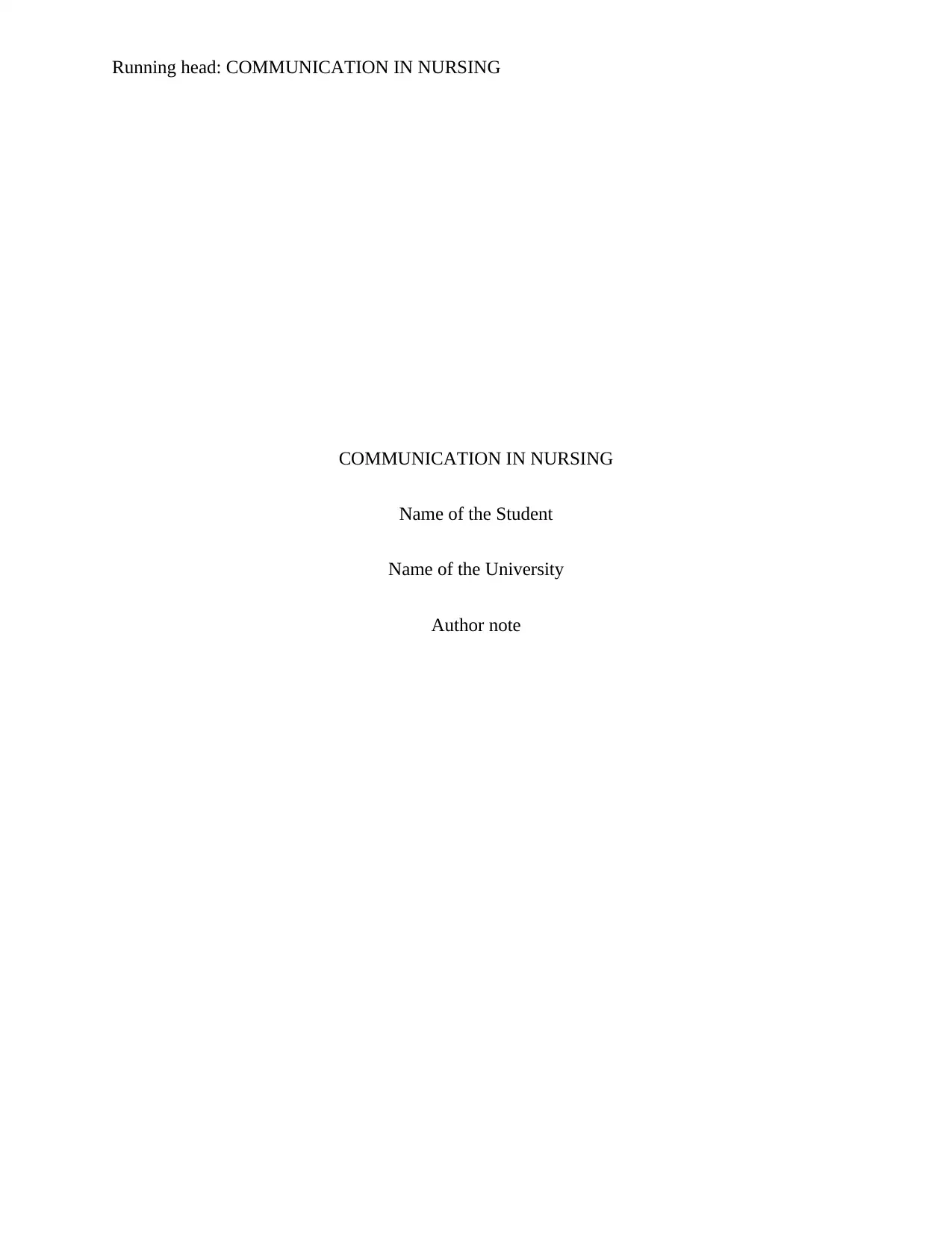
Running head: COMMUNICATION IN NURSING
COMMUNICATION IN NURSING
Name of the Student
Name of the University
Author note
COMMUNICATION IN NURSING
Name of the Student
Name of the University
Author note
Paraphrase This Document
Need a fresh take? Get an instant paraphrase of this document with our AI Paraphraser
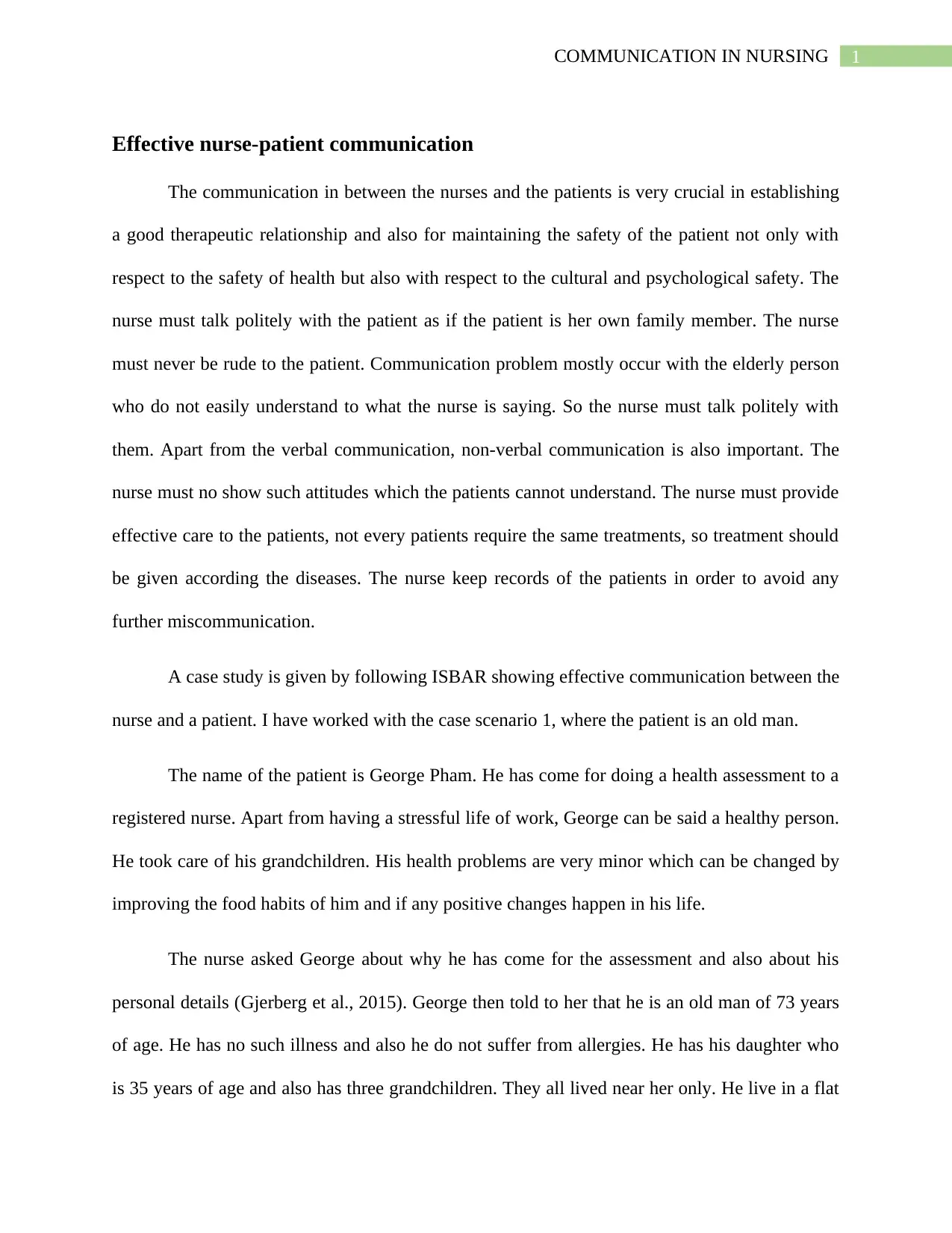
1COMMUNICATION IN NURSING
Effective nurse-patient communication
The communication in between the nurses and the patients is very crucial in establishing
a good therapeutic relationship and also for maintaining the safety of the patient not only with
respect to the safety of health but also with respect to the cultural and psychological safety. The
nurse must talk politely with the patient as if the patient is her own family member. The nurse
must never be rude to the patient. Communication problem mostly occur with the elderly person
who do not easily understand to what the nurse is saying. So the nurse must talk politely with
them. Apart from the verbal communication, non-verbal communication is also important. The
nurse must no show such attitudes which the patients cannot understand. The nurse must provide
effective care to the patients, not every patients require the same treatments, so treatment should
be given according the diseases. The nurse keep records of the patients in order to avoid any
further miscommunication.
A case study is given by following ISBAR showing effective communication between the
nurse and a patient. I have worked with the case scenario 1, where the patient is an old man.
The name of the patient is George Pham. He has come for doing a health assessment to a
registered nurse. Apart from having a stressful life of work, George can be said a healthy person.
He took care of his grandchildren. His health problems are very minor which can be changed by
improving the food habits of him and if any positive changes happen in his life.
The nurse asked George about why he has come for the assessment and also about his
personal details (Gjerberg et al., 2015). George then told to her that he is an old man of 73 years
of age. He has no such illness and also he do not suffer from allergies. He has his daughter who
is 35 years of age and also has three grandchildren. They all lived near her only. He live in a flat
Effective nurse-patient communication
The communication in between the nurses and the patients is very crucial in establishing
a good therapeutic relationship and also for maintaining the safety of the patient not only with
respect to the safety of health but also with respect to the cultural and psychological safety. The
nurse must talk politely with the patient as if the patient is her own family member. The nurse
must never be rude to the patient. Communication problem mostly occur with the elderly person
who do not easily understand to what the nurse is saying. So the nurse must talk politely with
them. Apart from the verbal communication, non-verbal communication is also important. The
nurse must no show such attitudes which the patients cannot understand. The nurse must provide
effective care to the patients, not every patients require the same treatments, so treatment should
be given according the diseases. The nurse keep records of the patients in order to avoid any
further miscommunication.
A case study is given by following ISBAR showing effective communication between the
nurse and a patient. I have worked with the case scenario 1, where the patient is an old man.
The name of the patient is George Pham. He has come for doing a health assessment to a
registered nurse. Apart from having a stressful life of work, George can be said a healthy person.
He took care of his grandchildren. His health problems are very minor which can be changed by
improving the food habits of him and if any positive changes happen in his life.
The nurse asked George about why he has come for the assessment and also about his
personal details (Gjerberg et al., 2015). George then told to her that he is an old man of 73 years
of age. He has no such illness and also he do not suffer from allergies. He has his daughter who
is 35 years of age and also has three grandchildren. They all lived near her only. He live in a flat
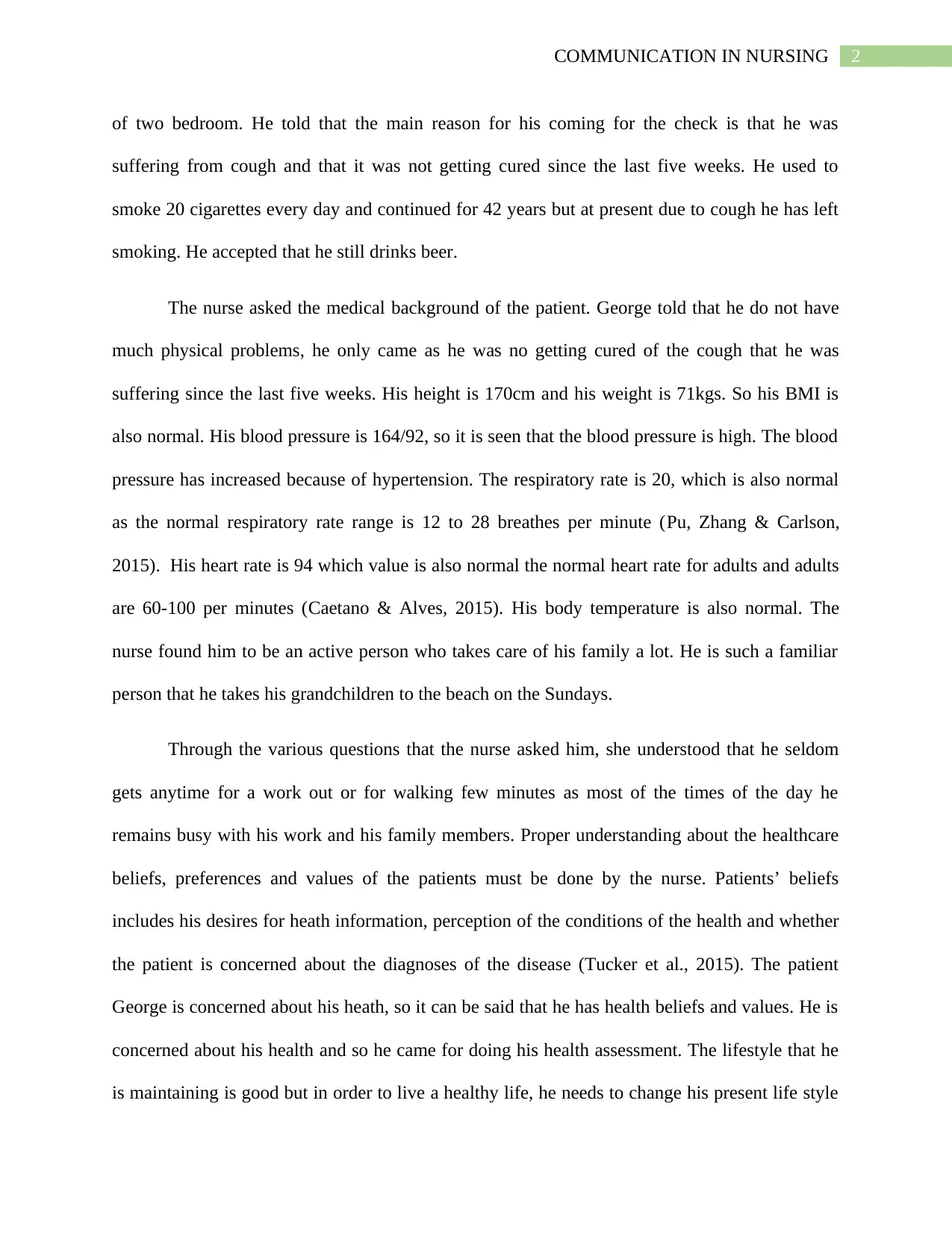
2COMMUNICATION IN NURSING
of two bedroom. He told that the main reason for his coming for the check is that he was
suffering from cough and that it was not getting cured since the last five weeks. He used to
smoke 20 cigarettes every day and continued for 42 years but at present due to cough he has left
smoking. He accepted that he still drinks beer.
The nurse asked the medical background of the patient. George told that he do not have
much physical problems, he only came as he was no getting cured of the cough that he was
suffering since the last five weeks. His height is 170cm and his weight is 71kgs. So his BMI is
also normal. His blood pressure is 164/92, so it is seen that the blood pressure is high. The blood
pressure has increased because of hypertension. The respiratory rate is 20, which is also normal
as the normal respiratory rate range is 12 to 28 breathes per minute (Pu, Zhang & Carlson,
2015). His heart rate is 94 which value is also normal the normal heart rate for adults and adults
are 60-100 per minutes (Caetano & Alves, 2015). His body temperature is also normal. The
nurse found him to be an active person who takes care of his family a lot. He is such a familiar
person that he takes his grandchildren to the beach on the Sundays.
Through the various questions that the nurse asked him, she understood that he seldom
gets anytime for a work out or for walking few minutes as most of the times of the day he
remains busy with his work and his family members. Proper understanding about the healthcare
beliefs, preferences and values of the patients must be done by the nurse. Patients’ beliefs
includes his desires for heath information, perception of the conditions of the health and whether
the patient is concerned about the diagnoses of the disease (Tucker et al., 2015). The patient
George is concerned about his heath, so it can be said that he has health beliefs and values. He is
concerned about his health and so he came for doing his health assessment. The lifestyle that he
is maintaining is good but in order to live a healthy life, he needs to change his present life style
of two bedroom. He told that the main reason for his coming for the check is that he was
suffering from cough and that it was not getting cured since the last five weeks. He used to
smoke 20 cigarettes every day and continued for 42 years but at present due to cough he has left
smoking. He accepted that he still drinks beer.
The nurse asked the medical background of the patient. George told that he do not have
much physical problems, he only came as he was no getting cured of the cough that he was
suffering since the last five weeks. His height is 170cm and his weight is 71kgs. So his BMI is
also normal. His blood pressure is 164/92, so it is seen that the blood pressure is high. The blood
pressure has increased because of hypertension. The respiratory rate is 20, which is also normal
as the normal respiratory rate range is 12 to 28 breathes per minute (Pu, Zhang & Carlson,
2015). His heart rate is 94 which value is also normal the normal heart rate for adults and adults
are 60-100 per minutes (Caetano & Alves, 2015). His body temperature is also normal. The
nurse found him to be an active person who takes care of his family a lot. He is such a familiar
person that he takes his grandchildren to the beach on the Sundays.
Through the various questions that the nurse asked him, she understood that he seldom
gets anytime for a work out or for walking few minutes as most of the times of the day he
remains busy with his work and his family members. Proper understanding about the healthcare
beliefs, preferences and values of the patients must be done by the nurse. Patients’ beliefs
includes his desires for heath information, perception of the conditions of the health and whether
the patient is concerned about the diagnoses of the disease (Tucker et al., 2015). The patient
George is concerned about his heath, so it can be said that he has health beliefs and values. He is
concerned about his health and so he came for doing his health assessment. The lifestyle that he
is maintaining is good but in order to live a healthy life, he needs to change his present life style
⊘ This is a preview!⊘
Do you want full access?
Subscribe today to unlock all pages.

Trusted by 1+ million students worldwide
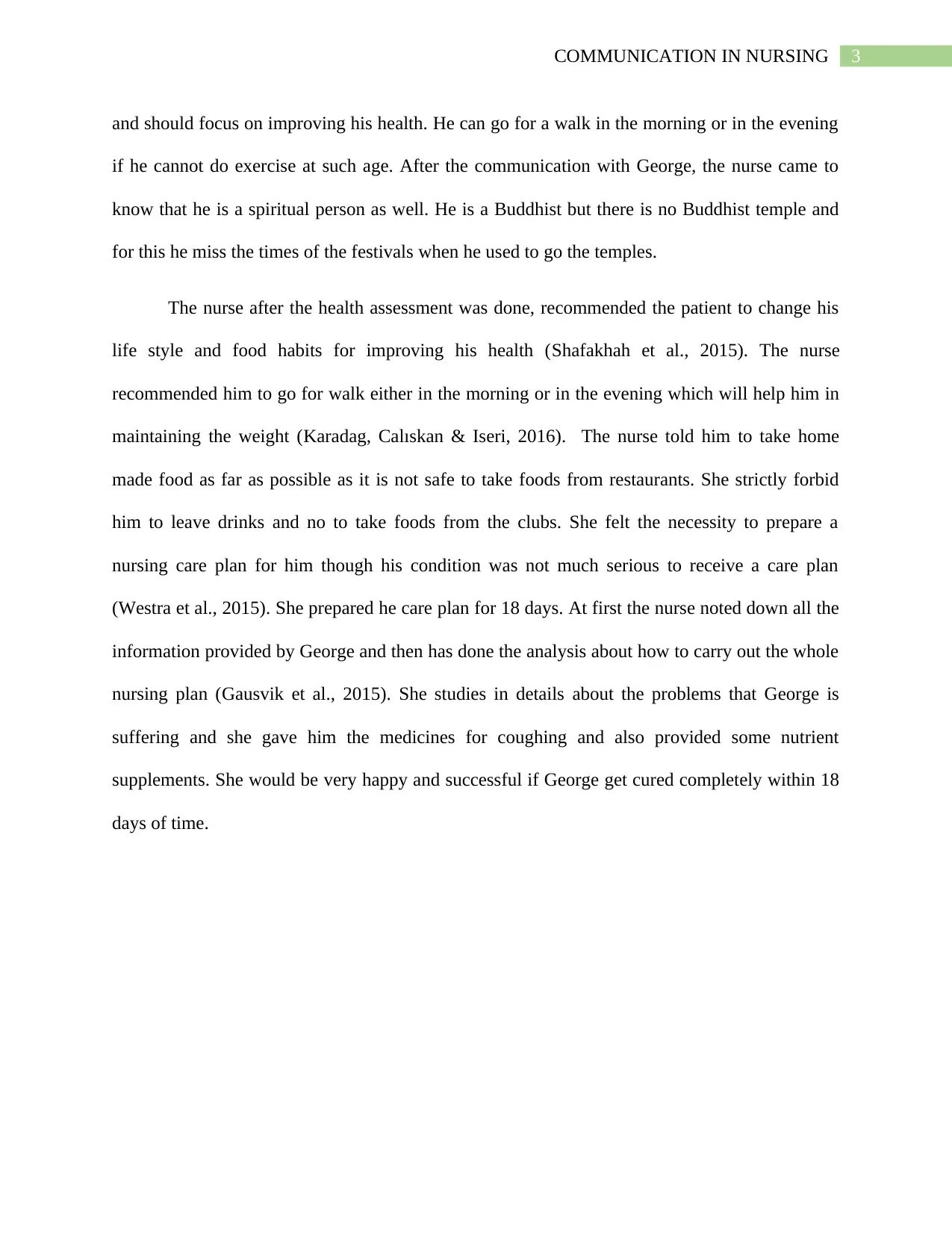
3COMMUNICATION IN NURSING
and should focus on improving his health. He can go for a walk in the morning or in the evening
if he cannot do exercise at such age. After the communication with George, the nurse came to
know that he is a spiritual person as well. He is a Buddhist but there is no Buddhist temple and
for this he miss the times of the festivals when he used to go the temples.
The nurse after the health assessment was done, recommended the patient to change his
life style and food habits for improving his health (Shafakhah et al., 2015). The nurse
recommended him to go for walk either in the morning or in the evening which will help him in
maintaining the weight (Karadag, Calıskan & Iseri, 2016). The nurse told him to take home
made food as far as possible as it is not safe to take foods from restaurants. She strictly forbid
him to leave drinks and no to take foods from the clubs. She felt the necessity to prepare a
nursing care plan for him though his condition was not much serious to receive a care plan
(Westra et al., 2015). She prepared he care plan for 18 days. At first the nurse noted down all the
information provided by George and then has done the analysis about how to carry out the whole
nursing plan (Gausvik et al., 2015). She studies in details about the problems that George is
suffering and she gave him the medicines for coughing and also provided some nutrient
supplements. She would be very happy and successful if George get cured completely within 18
days of time.
and should focus on improving his health. He can go for a walk in the morning or in the evening
if he cannot do exercise at such age. After the communication with George, the nurse came to
know that he is a spiritual person as well. He is a Buddhist but there is no Buddhist temple and
for this he miss the times of the festivals when he used to go the temples.
The nurse after the health assessment was done, recommended the patient to change his
life style and food habits for improving his health (Shafakhah et al., 2015). The nurse
recommended him to go for walk either in the morning or in the evening which will help him in
maintaining the weight (Karadag, Calıskan & Iseri, 2016). The nurse told him to take home
made food as far as possible as it is not safe to take foods from restaurants. She strictly forbid
him to leave drinks and no to take foods from the clubs. She felt the necessity to prepare a
nursing care plan for him though his condition was not much serious to receive a care plan
(Westra et al., 2015). She prepared he care plan for 18 days. At first the nurse noted down all the
information provided by George and then has done the analysis about how to carry out the whole
nursing plan (Gausvik et al., 2015). She studies in details about the problems that George is
suffering and she gave him the medicines for coughing and also provided some nutrient
supplements. She would be very happy and successful if George get cured completely within 18
days of time.
Paraphrase This Document
Need a fresh take? Get an instant paraphrase of this document with our AI Paraphraser
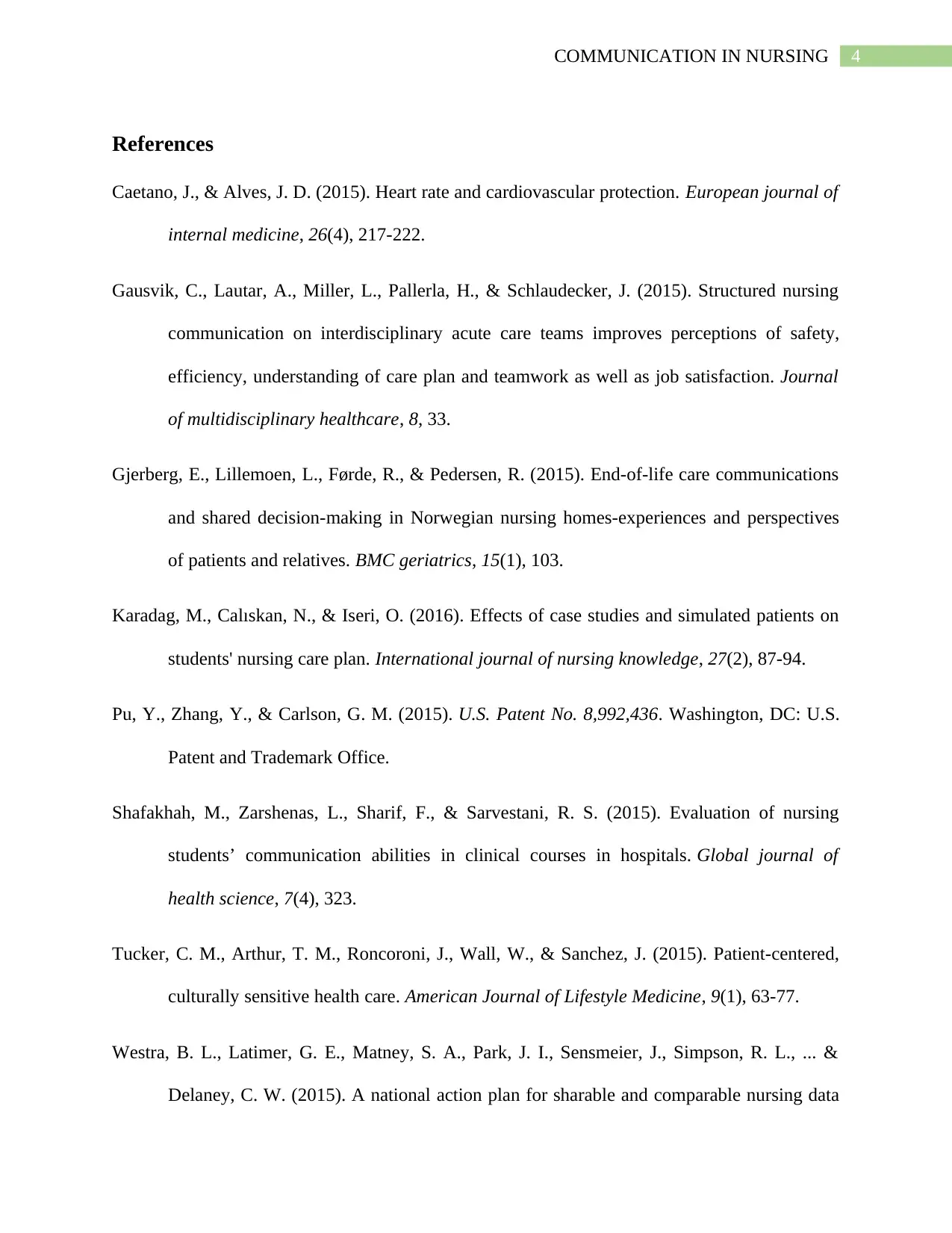
4COMMUNICATION IN NURSING
References
Caetano, J., & Alves, J. D. (2015). Heart rate and cardiovascular protection. European journal of
internal medicine, 26(4), 217-222.
Gausvik, C., Lautar, A., Miller, L., Pallerla, H., & Schlaudecker, J. (2015). Structured nursing
communication on interdisciplinary acute care teams improves perceptions of safety,
efficiency, understanding of care plan and teamwork as well as job satisfaction. Journal
of multidisciplinary healthcare, 8, 33.
Gjerberg, E., Lillemoen, L., Førde, R., & Pedersen, R. (2015). End-of-life care communications
and shared decision-making in Norwegian nursing homes-experiences and perspectives
of patients and relatives. BMC geriatrics, 15(1), 103.
Karadag, M., Calıskan, N., & Iseri, O. (2016). Effects of case studies and simulated patients on
students' nursing care plan. International journal of nursing knowledge, 27(2), 87-94.
Pu, Y., Zhang, Y., & Carlson, G. M. (2015). U.S. Patent No. 8,992,436. Washington, DC: U.S.
Patent and Trademark Office.
Shafakhah, M., Zarshenas, L., Sharif, F., & Sarvestani, R. S. (2015). Evaluation of nursing
students’ communication abilities in clinical courses in hospitals. Global journal of
health science, 7(4), 323.
Tucker, C. M., Arthur, T. M., Roncoroni, J., Wall, W., & Sanchez, J. (2015). Patient-centered,
culturally sensitive health care. American Journal of Lifestyle Medicine, 9(1), 63-77.
Westra, B. L., Latimer, G. E., Matney, S. A., Park, J. I., Sensmeier, J., Simpson, R. L., ... &
Delaney, C. W. (2015). A national action plan for sharable and comparable nursing data
References
Caetano, J., & Alves, J. D. (2015). Heart rate and cardiovascular protection. European journal of
internal medicine, 26(4), 217-222.
Gausvik, C., Lautar, A., Miller, L., Pallerla, H., & Schlaudecker, J. (2015). Structured nursing
communication on interdisciplinary acute care teams improves perceptions of safety,
efficiency, understanding of care plan and teamwork as well as job satisfaction. Journal
of multidisciplinary healthcare, 8, 33.
Gjerberg, E., Lillemoen, L., Førde, R., & Pedersen, R. (2015). End-of-life care communications
and shared decision-making in Norwegian nursing homes-experiences and perspectives
of patients and relatives. BMC geriatrics, 15(1), 103.
Karadag, M., Calıskan, N., & Iseri, O. (2016). Effects of case studies and simulated patients on
students' nursing care plan. International journal of nursing knowledge, 27(2), 87-94.
Pu, Y., Zhang, Y., & Carlson, G. M. (2015). U.S. Patent No. 8,992,436. Washington, DC: U.S.
Patent and Trademark Office.
Shafakhah, M., Zarshenas, L., Sharif, F., & Sarvestani, R. S. (2015). Evaluation of nursing
students’ communication abilities in clinical courses in hospitals. Global journal of
health science, 7(4), 323.
Tucker, C. M., Arthur, T. M., Roncoroni, J., Wall, W., & Sanchez, J. (2015). Patient-centered,
culturally sensitive health care. American Journal of Lifestyle Medicine, 9(1), 63-77.
Westra, B. L., Latimer, G. E., Matney, S. A., Park, J. I., Sensmeier, J., Simpson, R. L., ... &
Delaney, C. W. (2015). A national action plan for sharable and comparable nursing data
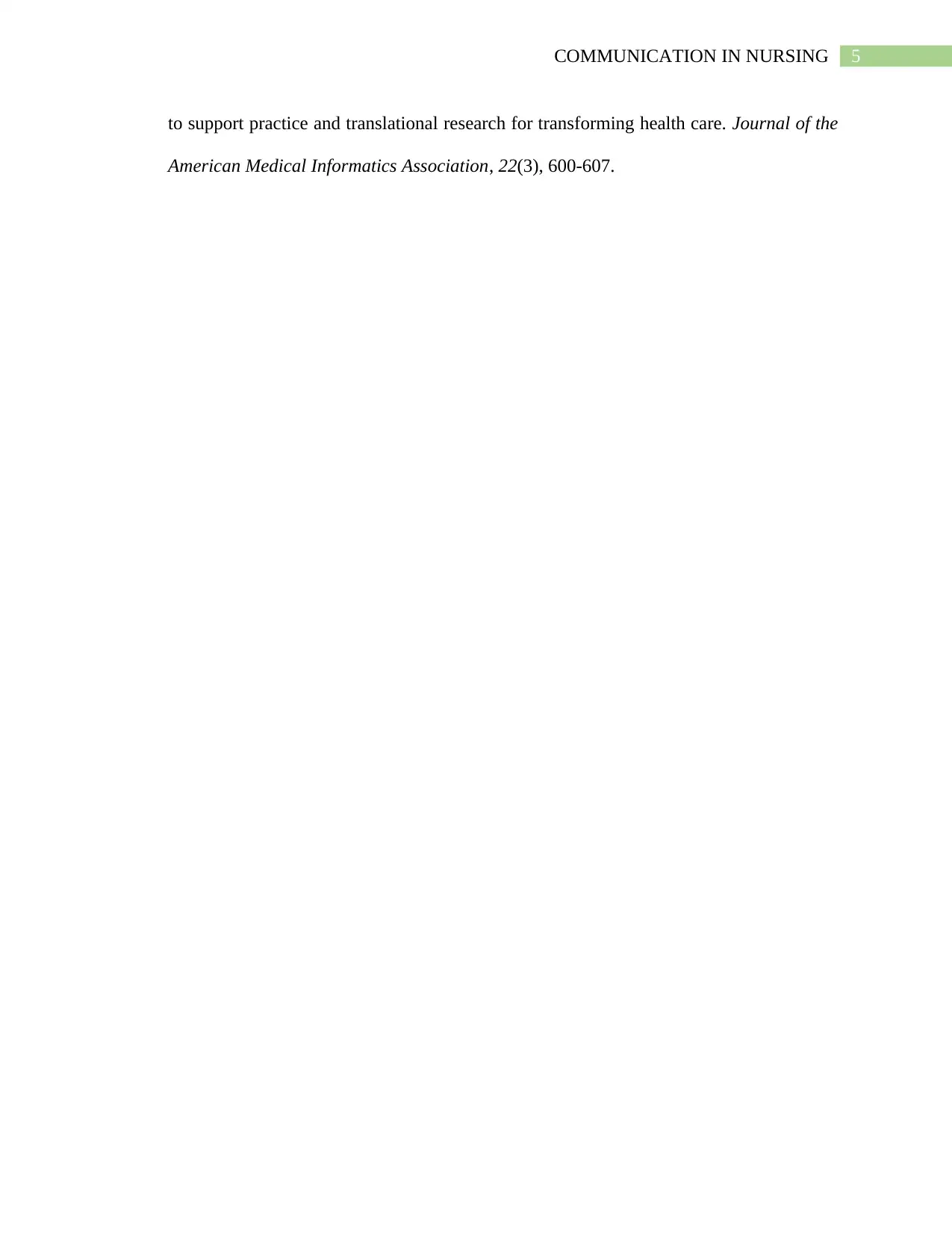
5COMMUNICATION IN NURSING
to support practice and translational research for transforming health care. Journal of the
American Medical Informatics Association, 22(3), 600-607.
to support practice and translational research for transforming health care. Journal of the
American Medical Informatics Association, 22(3), 600-607.
⊘ This is a preview!⊘
Do you want full access?
Subscribe today to unlock all pages.

Trusted by 1+ million students worldwide
1 out of 6
Related Documents
Your All-in-One AI-Powered Toolkit for Academic Success.
+13062052269
info@desklib.com
Available 24*7 on WhatsApp / Email
![[object Object]](/_next/static/media/star-bottom.7253800d.svg)
Unlock your academic potential
Copyright © 2020–2025 A2Z Services. All Rights Reserved. Developed and managed by ZUCOL.





